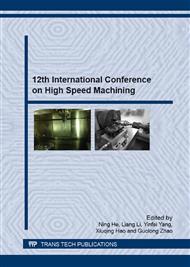[1]
G. Byrne, D. Dornfeld, B. Denkena, Advancing cutting technology, CIRP Annals-Manufacturing Technology, 2003, 52(2): 483-507.
DOI: 10.1016/s0007-8506(07)60200-5
Google Scholar
[2]
J.S. Strenkowski, J.T. Carroll, A finite element model of orthogonal metal cutting, Journal of Manufacturing Science and Engineering, 1985, 107(4): 349-354.
DOI: 10.1115/1.3186008
Google Scholar
[3]
Y.C. Yen, P. Sartkulvanich, T. Altan, Finite element modeling of roller burnishing process, CIRP Annals-Manufacturing Technology, 2005, 54(1): 237-240.
DOI: 10.1016/s0007-8506(07)60092-4
Google Scholar
[4]
Y.J. Chao, X. Qi, Thermal and thermo-mechanical modeling of friction stir welding of aluminum alloy 6061-T6, Journal of materials processing and manufacturing science, 1998 (7): 215-233.
DOI: 10.1106/ltkr-jfbm-rgmv-wvcf
Google Scholar
[5]
L.H. Meng, N. He, L. Li, et al, Measurement of the Residual Stress Induced by Milling in TC4 Workpiece before Self-Balancing and Its FEA, Rare Metal Materials and Engineering, 2014, 43(8): 1991-1996. (in Chinese).
Google Scholar
[6]
L.H. Meng, N. He, L. Li, et al, et al, Measurement of Pre-Self-Balanced Surface Residual Stresses Induced by Milling in Titanium Alloys and the FEM Validation, Advanced Materials Research. 2014, 996: 615-621.
DOI: 10.4028/www.scientific.net/amr.996.615
Google Scholar
[7]
L.H. Meng, N. He, L. Li, et al, Calculation of Residual Stress Induced by Machining in Internal Surface of TC4 Tubular Parts and Its FEA, China Mechanical Engineering, 2014, 25(19): 2583-2587. (in Chinese).
Google Scholar
[8]
L.H. Meng, N. He, Y.F. Yang, et al, Method for Measuring Residual Stresses Induced by Boring in Internal Surface of Tube and Its Validation with XRD Method, Transactions of Nanjing University of Aeronautics and Astronautics, 2014, 31(5): 508-514.
Google Scholar
[9]
L.H. Meng, N. He, Y.F. Yang, et al, Application of FEM correction to measuring the surface residual stresses generated by turning Ti6A14V tube parts, Journal of Harbin Institute of Technology, 2015, 47(5): 71-75. (in Chinese).
Google Scholar
[10]
J.T. Carroll, J.S. Strenkowski, Finite element models of orthogonal cutting with application to single point diamond turning, International Journal of Mechanical Sciences, 1988, 30(12): 899-920.
DOI: 10.1016/0020-7403(88)90073-2
Google Scholar
[11]
P.V. Bayly, J.E. Halley, B.P. Mann, et al, Stability of interrupted cutting by temporal finite element analysis, Journal of Manufacturing Science and Engineering, 2003, 125(2): 220-225.
DOI: 10.1115/1.1556860
Google Scholar
[12]
J.S. Strenkowski, K.J. Moon, Finite element prediction of chip geometry and tool/workpiece temperature distributions in orthogonal metal cutting, Journal of Manufacturing Science and Engineering, 1990, 112(4): 313-318.
DOI: 10.1115/1.2899593
Google Scholar
[13]
C.R. Liu, Y.B. Guo, Finite element analysis of the effect of sequential cuts and tool–chip friction on residual stresses in a machined layer, International Journal of Mechanical Sciences, 2000, 42(6): 1069-1086.
DOI: 10.1016/s0020-7403(99)00042-9
Google Scholar


